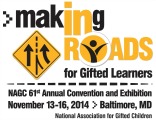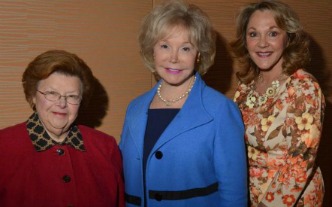NAGC works to support those who enhance the growth and development of gifted and talented children through education, advocacy, community building, and research

Experiencing the 61st Annual NAGC Convention during my second year as NAGC President has allowed for some different kinds of observations to be made when compared to my first year in the role. My first year experience was very primal and personal. NAGC was held last year in Indianapolis, my stomping grounds for 16 years, where my children grew up, and where I have many friends and longstanding colleagues. I could not escape the immediacy of all the experiences. Because of these close connections, I felt considerable nostalgia and worry. The 2013 Convention was a great success and my concerns were unfounded.
A year later, the experience was overwhelmingly positive, but in a more objective way. In only a year’s time, I have learned a great deal. For example, I learned to have faith that all the planning and hard work by the NAGC staff would lead to a great Convention; to know that the wide diversity of viewpoints among the many planners will lead to great keynote speakers; and to have confidence that under the direction of George Betts (NAGC President Elect and Program Chair), Shelagh Gallagher (veteran Program Committee member), and Robin Feldman (NAGC’s Director of Professional Development and Meetings), a terrific set of sessions would be offered. Moreover, meeting and collaborating with the myriad leaders of NAGC’s Networks, Committees, and Board provided considerable evidence in the months before that the 61st NAGC Conference would be a great success.
This year I decided to reduce my role as academic presenter and expand my role as ambassador. This change enabled me to attend a wide range of sessions. This expanded experience provided insight not available during my first year. My characterization of the 61st NAGC Convention begins with the recognition that geography matters. By virtue of being in Baltimore, conference planners were able to benefit from this historic and vibrant city. Dr. Freeman Hrabowski, President of the University of Maryland Baltimore County, provided an incredible keynote speech that affected many of us, both intellectually and emotionally. Nancy Grasmick and Jean Paynter were presented the NAGC President’s Award for their longstanding  commitment to the betterment of the education of gifted students. Later, we presented the David W. Belin Advocacy Award to the Senator Barbara Mikulski, who was able to gain support for the reinstatement of the Jacob Javits federal grant monies for gifted education (pictured at right, from l-r: Mikulski, Grasmick, Paynter). A more historical figure named Dr. Martin Jenkins, former President of Morgan State University located in Baltimore area, was a significant figure in the history of the field of gifted education, especially as it pertains to African American gifted students. These five professionals embodied the very significant role that Maryland plays in the education of gifted students both historically and now. Place matters. Now add the crab cakes, and you must agree that Maryland rocks.
commitment to the betterment of the education of gifted students. Later, we presented the David W. Belin Advocacy Award to the Senator Barbara Mikulski, who was able to gain support for the reinstatement of the Jacob Javits federal grant monies for gifted education (pictured at right, from l-r: Mikulski, Grasmick, Paynter). A more historical figure named Dr. Martin Jenkins, former President of Morgan State University located in Baltimore area, was a significant figure in the history of the field of gifted education, especially as it pertains to African American gifted students. These five professionals embodied the very significant role that Maryland plays in the education of gifted students both historically and now. Place matters. Now add the crab cakes, and you must agree that Maryland rocks.
Jack Andraka (another Marylander) reminded us why it is critical to research, serve, and advocate for gifted students. During his presentation, he was impressive, funny, thoughtful, and humbling. How many more gifted students like Jack are out there?
Another important aspect of this year’s Convention was the honoring of both the present and the past. There were myriad sessions on best practices, research and so forth guiding us into the future, and there were sessions that honored those who were trailblazers in the field. For example, this year the NAGC Legacy Series, coordinated by the Conceptual Foundations Network, honored Dr. Joyce VanTassel-Baska for her unparalleled career. Hundreds of people participated in this event. We also sponsored events honoring two critical pioneers in the field of gifted education who passed away in the last year. Dr. Abraham Tannenbaum and Dr. James Gallagher were celebrated by colleagues, friends, and family alike. The sessions were moving, while serving as a history lesson of their significant contributions to the field. Whether it was the profound theories of Dr. Tannenbaum, or significant books they both contributed that provided substance to gifted education, or the origination of the Individual Educational Plan credited to Dr. Gallagher, both earned the admiration and respect of colleagues in the field. Perhaps the most noteworthy lesson learned during the two separate events was the extent that the doctoral students who studied for years with these men grew to revere them. It was the caliber of the human being that led to their greatness in their professional lives. What a great lesson of which to be reminded.
In sum, the 61st NAGC Convention was quite a success. Great speakers, great sessions, great colleagues, great food – all in an historical city. In my journey as President of NAGC, I have become absolutely confident that my Board colleagues, and leaders throughout NAGC, will carry on this great tradition of creating a successful conference. In short order it will be incumbent upon me to step aside and let the next generation of leaders carry on. It is critical to our field that this transition occurs. Hooray to our field for having such impressive pioneers, such great current leaders, and such a great group to lead in the future. And, with apologies to Timbuk 3, as we prepare for Arizona next year, I can say that our future is so bright that we have to wear shades.